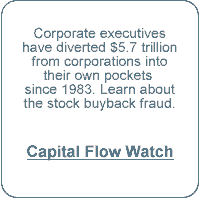 Stock Buybacks, Dividends, and Capital Flows
Stock Buybacks, Dividends, and Capital Flows
Stock Buybacks and Dividends
Can Buybacks Go On Forever?
The end may also come when companies no longer can generate cash to buy back enough stocks to continue to force prices upwards.
The chart shows that American corporations since 1980 have been distributing an increasing percentage of profits as dividends and buybacks, reversing the earlier trend of reinvesting in the future.
Obviously, the higher the price-earnings ratio, the more buyback money it takes to force prices upwards.
Eventually a point is reached when corporations are simply not generating enough cash to continue effective manipulation of their stock prices.
Eventually, corporations cannot generate enough cash to continue manipulating the market
The end to buyback pressure on prices may also come through new issues floated by foreign corporations.
As the chart in Lesson 14 shows, high price-earnings ratios attracted a greater volume of foreign offerings, offsetting to some degree the effect of domestic buybacks.
In fact, in 2000, foreign issues reached the point that an extremely high volume of corporate buybacks was effectively neutralized.
This is part of the explanation why the Great Bubble burst in that year.
The Analyst's Advantage
Perhaps the most interesting aspect of the buyback / option movement is that the macro-economic effects passed almost unperceived throughout the 1980s and the 1990s, although the trend could clearly be read from the Federal Reserve flow of funds accounts.
Rising foreign issues and withdrawal of sophisticated investors signaled the end of the Great Bubble.
Wall Street was simply making too much money off the practice to raise any questions, the SEC was asleep, and ordinary investors were lost in the dream world of the Common Stock Legend.
A Capital Flow Analyst following the flow of funds accounts in the year 2000 might have understood the implications of the rise in foreign stock offerings and the withdrawal of state and local pension fund investment from equities in that year.
The fact that so few were looking in this direction indicates the potential of Capital Flow Analysis in helping those who want to get a jump on the market.
Before proceeding, check your progress:
Self-Test
During the last quarter of the 20th century, American corporations:
|
|
Buybacks are unfair because:
|
|
The primary beneficiaries of stock buybacks are:
|
 learning module : continued >
learning module : continued >


